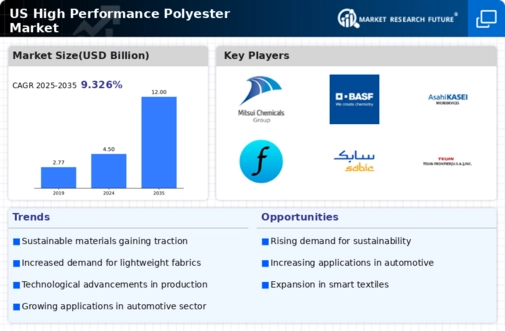The US High Performance Polyester Market is characterized by a dynamic competitive landscape driven by advancements in production technology and increasing demand across various sectors, including automotive, textiles, and industrial applications. This market is witnessing significant growth fueled by the need for materials that offer superior performance characteristics such as durability, thermal stability, and resistance to chemicals and moisture. Key players in this sector continuously innovate to enhance product offerings and cater to the diverse needs of end-users. The competitive environment is marked by strategic collaborations, investments in research and development, and expansion efforts to strengthen market presence.
As companies seek to differentiate themselves, they are prioritizing sustainability and eco-friendly practices, which are becoming increasingly important to consumers and regulatory bodies alike. Mitsui Chemicals stands out in the US High Performance Polyester Market with its strong focus on innovation and superior product quality. The company has established a significant presence through its commitment to research and development, resulting in the development of high-performance materials tailored to the needs of various industries. This focus has allowed Mitsui Chemicals to leverage its technical expertise and create specialized polyester products that meet stringent performance standards.
Additionally, the company's strategic partnerships within the industry have further solidified its position, enabling it to deliver enhanced solutions that cater to evolving market demands. Mitsui Chemicals' capacity to respond swiftly to changes in customer requirements and market trends reflects its strengths in maintaining competitiveness in the high-performance polyester sector.Celanese Corporation holds a prominent role in the US High Performance Polyester Market, particularly known for its robust portfolio of specialty polymers and engineered materials. The company offers a range of high-performance polyesters designed for applications requiring exceptional mechanical properties and temperature resistance.
Celanese has strengthened its market presence through strategic mergers and acquisitions, allowing it to integrate advanced technologies and broaden its product offerings. By continuously investing in innovation, Celanese is able to provide tailored solutions that address specific industrial needs, ultimately enhancing its competitive edge. The company's dedication to sustainability is evident in its development of eco-friendly product options, positioning it favorably in a market where environmental considerations are increasingly essential. With a well-established reputation as a leader in high-performance materials, Celanese Corporation remains well-equipped to meet the challenges and opportunities of the US High Performance Polyester Market.




















Leave a Comment